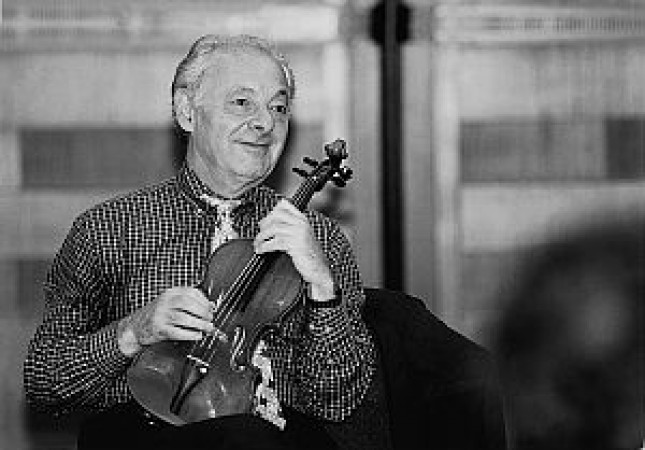
26 October, 1936 – 18 November, 2024
György Pauk named the violin department which he heads at the Royal Academy of Music in London after Ede Zathureczky, because he would like to preserve and carry on the legacy of the legendary master. "There is no day when I do not think of him," he said. "He was one of the greatest figures of Hungarian violin playing, a personality who must not be forgotten."
György Pauk began his studies at the Music Academy in 1945, as Imre Waldbauer's pupil. From 1947-49 he studied with János Temesváry, and from 1949 till he graduated at the Academy with Ede Zathureczky. He has been giving regular concerts ever since 1952 – at first in Hungary and Eastern Europe. In 1958 he left the country and in 1961 settled in London. Pauk won first prize at the Paganini violin competition in Geneva in 1956. In the same year he won, in partnership with Péter Frankl, the Münnich Sonata Competition. In 1959 he received the first prize at the Jacques Thibaud competition in Paris.
His international career accelerated after 1961. In 1971 Georg Solti invited him to play with the Chicago Symphony Orchestra, followed by an invitation to New York from Antal Doráti. Ever since that time he has played with the greatest American orchestras.
Pauk has a very wide repertoire. It includes all the Mozart concertos and sonatas – which he also recorded – the Schubert sonatas, and Bartók's works written for the violin. He is also a committed adherent of contemporary music. At the Osaka Festival he performed for the first time Penderecki's violin concerto, with the composer conducting. "It is contrary to my philosophy to play something out of routine. That is why I always need something new; I constantly endeavour to refresh my repertoire, to make it more colourful. I performed many twentieth century pieces, works by Lutoslawski or Schnittke, for the first time. I like contemporary music." As concerto soloist he worked with Pierre Boulez, Sir Colin Davis, Lorin Maazel, Rozhdestvenskiy, Simon Rattle and Sir Georg Solti.
Pauk has played trio pieces with Péter Frankl and Ralph Kirshbaum since 1972. Pauk and Frankl have been permanent partners since they were children. They studied chamber music with Leo Weiner. At Annie Fischer's encouragement and invitation, in 1973 Pauk appeared once again in Budapest; since then he has been a frequent performer in Hungary both as soloist and as chamber musician.
He is rightly regarded as the successor to the Hungarian school of violin playing marked by the names of József Szigeti, Zoltán Székely and Ede Zathureczky. "I never heard the two (Bartók) sonatas performed by Ede Zathureczky, but Pauk's whole disposition as a violinist, and often his sound, too, definitely remind me of Zathureczky's playing", György Kroó reported his concert impressions in 1976. His performing style and his sound have continuously changed, developed, become richer over the years. After a 1985 concert, Kroó depicted the direction of this enrichment as follows: "Without having lost any of his sparkle and intensity, the sound of the violin – this is the only way I can express it - appears to have moved back from the middle of the 19th century to the beginning of the 19th century: it is simpler, smoother, without any unnecessary decoration, with more depth behind it, perhaps less brilliant: a chamber music sound." In 1995, after a performance of Vivaldi's Four Seasons, Kroó noted: "…one can sense something also of the productive, let us say Gardiner-like atmosphere of the London early music performances, for example in the decorations of the melody in the Largo in E-flat major." At the end of 1999 Pauk said: "Nowadays I am trying to discover the secrets of baroque music. Today you can no longer play Bach or Handel as we learned to do forty years ago. For me neither that, nor the period style of playing favoured nowadays is truly right, so I try to find a middle way."
S. M.


